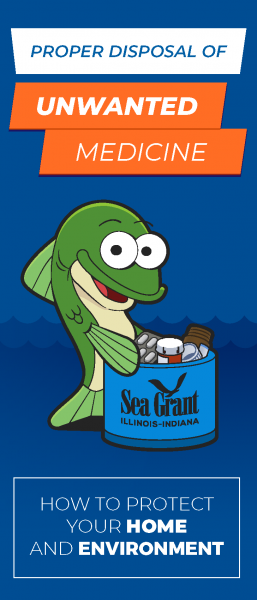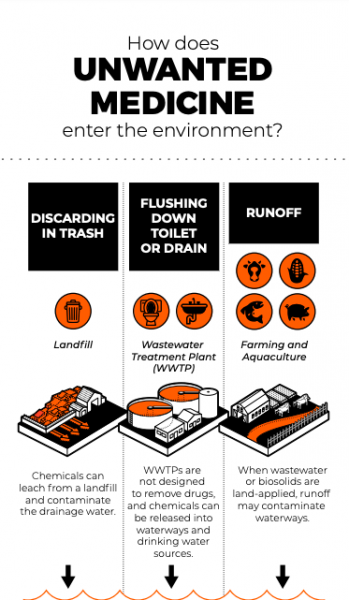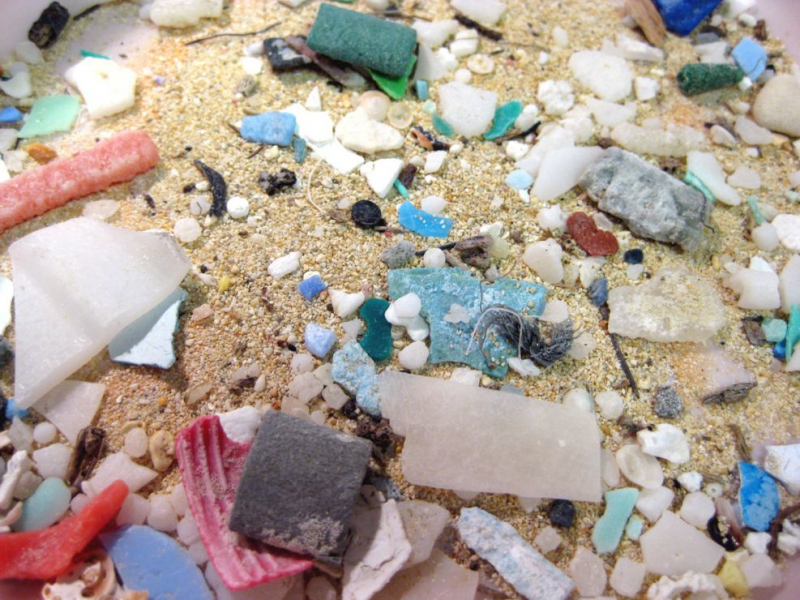This week, we’re taking a look at the different types of urban industrial pollution, how NOAA responds to pollution events and aids in the recovery of natural resources lost due to pollution, and what you can do to help keep pollution out of your waterway. Stay tuned as we explore these topics through a series of blogs. In our latest blog, NOAA’s Illinois-Indiana Sea Grant Pollution Prevention Extension Specialist Sarah Zack shares tips for how to reduce your household pollution footprint.

A variety of partnerships across governmental agencies, industry, and educational institutions play an important role in NOAA’s mission to keep our coasts clean from threats of oil, chemicals, and marine debris. One partnership of special importance is the Sea Grant network—a federal/university partnership between NOAA and 34 university-based programs in every coastal and Great Lakes state.
The Sea Grant network draws on the expertise of more than 3,000 scientists, engineers, public outreach experts, educators, and students who help citizens better understand, conserve, and utilize America’s coastal resources. Without this network of experts, much of NOAA’s most important work, research, and public outreach wouldn’t be possible.
Sarah Zack is a pollution prevention extension specialist with the Illinois-Indiana Sea Grant program and the University of Illinois Extension. She develops and conducts extension and outreach activities related to the prevention of aquatic pollution, raising awareness of the impacts of household pollutants—such as pharmaceuticals, personal care products, microplastics, and other contaminants of emerging concern on water quality, human health, and aquatic ecosystems.
These activities include working with the NOAA Marine Debris Program to implement the Marine Debris Action Plan in the Lake Michigan coastal waters of Illinois and Indiana, assisting communities in developing unwanted medicine take-back programs, and leading development of the 10-Year Water Resources Vision for the National Sea Grant Program.
When it comes to household pollutants, Sarah said there are three major areas where people can reduce their footprint and overall environmental impact. Check out some of her tips below.
Responsibly Dispose of Your Leftover or Expired Medication

A 2006 U.S. Geological Survey study found traces of painkillers, estrogen, antidepressants, and blood-pressure medicines in water samples from 30 states. In 2010, an Illinois-Indiana Sea Grant study found traces of those same pharmaceuticals in nearshore waters of Lake Michigan.
“My position really came out of a partnership that Sea Grant has with the U.S. Environmental Protection Agency’s Great Lakes National Program Office, and the main driving issue was pharmaceutical pollution,” Sarah said. “There’s a lot of potential for unwanted or expired medicine to be disposed of improperly. It’s an issue of personal responsibility in the household, how can folks reduce pollution at home?”
When pharmaceuticals expire or prescriptions change, this can present a challenge—how to properly dispose of these unwanted medicines. Drugs that are flushed or thrown in the trash can end up in nearby waterways. And keeping them around the house can be unsafe for children or pets who might accidentally ingest them.
The program first started doing single-day medicine take back events to coincide with Earth Day. Previous guidance had encouraged people not to put pharmaceuticals in the trash due to the risk to children or pets. They were instead told to flush them. But after traces of drugs found in aquatic ecosystems were discovered to have negative impacts on aquatic organisms, the program immediately began outreach to get the word out.
“It’s both a public health issue, and an environmental one,” Sarah said. “So we started doing a big push for people to clean out their medicine cabinets, and we help give people a way to responsibly dispose of what they hand over. We’ve had a lot of success over the course of the ‘Unwanted Meds’ program."
Over the more than 10 years since the program started, Illinois-Indiana Sea Grant has supported community programs in four Great Lakes states in collecting and properly disposing of over 275,000 pounds, or 139 tons, of medicine. The program supports both single-day and long-term collections, often working with local police departments and other agencies.
“People are often surprised to learn that a very small amount of a pharmaceutical that doesn’t impact people at all can actually be quite harmful to an aquatic animal. This is an important message that we share in our outreach efforts,” Sarah said.
Here are four tips to help reduce the environmental impact of your medicine cabinet:
- Buy only what you need. Take all medication as prescribed by your physician, wait to refill prescriptions until you need them, and avoid pharmacy auto-refill programs.
- Store medicine in one place. Centralize all medicine in one secure location to prevent overpurchasing products you already have.
- Store medicine properly. In order to preserve its quality, store medicine as recommended on the label. Avoid placing multiple, unlabeled medications in one container.
- Say no to physician samples. Say no to physician samples if you are not going to use them, and make sure your prescriber provides directions to ensure the medicine is taken correctly.
Check out these “Unwanted Meds” resources to learn more:
- “Proper Disposal of Unwanted Medicine: How to Protect Your Home and Environment.”
- “10 years of IISG-supported community medicine collection adds up to over 200,000 pounds.”
- “Why Create a Medicine Takeback Program in Your Community?”
Avoid Harmful Chemicals and Choose Natural Lawn Care

“With lawn care, people are really surprised to learn the impact that what they put on or do to their lawn can have,” Sarah said. “They may not realize it, but every lawn is part of a watershed.”
Every home is connected to a watershed and part of its own unique ecosystem. Even if a homeowner does not live right next to a lake or stream, runoff can still end up in nearby waterbodies through a network of curbs, gutters, and storm drains. When you combine excess use of fertilizers and pesticides, overwatering, and compacted soils in urban environments, the risk of polluted runoff increases.
Keep your lawn care natural and prevent impacts to your watershed with these Sea Grant tips:

- Build healthy soil. Healthy soil is essential for healthy plants. A soil test will tell if adequate nutrients are available for plant growth. If your soil test shows that you need to add nutrients, consider using non-synthetic products like compost, which contains plenty of nitrogen, phosphorus, and potassium and organic matter that improves the soil’s ability to hold water and retain beneficial microorganisms.
- Let nature do the work. Use natural, non-synthetic fertilizers. Compost and plant and animal-based fertilizers improve soil and turf health without causing the degree of polluted runoff associated with synthetic options. Pesticides also kill unintended, beneficial organisms that are critical to soil health and keep lawns from building up thatch.
- Shrink your lawn. Focus on what you want from your landscape—for example, a play area for kids or pets or an attractive border—and design and maintain your landscape based on how it will be used. Reducing unnecessary lawn area will help to cut down on maintenance expenses.
- Right plant, right place. Different plants have specific water, nutrient, and light requirements. Poorly adapted plants are susceptible to attack by disease and pests. Choosing appropriate plants for your area can cut down on lawn care expenses. Avoid invasive plants that can outcompete native plants.
- Let the rain soak in and water smart. Capturing or filtering rainwater on your property provides several benefits, such as reduced runoff and minimized erosion and nutrient loading in nearby waterways. You can use water wisely by integrating cisterns and rain barrels, rain gardens, and permeable pavers into your landscape design. Consider letting your lawn go dormant in the summer or other dry periods. If you choose to irrigate, limit watering to one inch per week including rainfall, and minimize evaporative waste by watering in the morning or evenings, as needed.
Check out these additional Sea Grant resources for more tips on how to keep your lawn care routine natural:
- Managing Lawn Pests with Fewer Chemicals.
- Right Plant, Right Place: Selecting Turfgrass for Homeowners.
- Soil Testing for a Healthy Lawn.
- Visit the Lawn to Lake website for more information.
How to Reduce Your Use and Prevent Microplastics

NOAA defines marine debris as any persistent solid material that is manufactured or processed and directly or indirectly, intentionally or unintentionally, disposed of or abandoned into the marine environment or the Great Lakes. “Microplastics” are pieces of plastic that are less than 5mm long. Microplastics can come from larger pieces of plastic that have broken down over and over again. Or, microplastics can be manufactured. For example, pre-production industrial plastic pellets or plastic "micro-scrubbers" in face wash are considered microplastics.
“I think people are kind of used to issues with beach litter. Marine debris is a really easy concept for people to wrap their heads around because you can see it and you know it’s bad. It’s important to get rid of it, keep trash off the beaches and out of the water,” Sarah said. “But microplastics are something people are less familiar with, and they’re eager to find solutions. These tiny things have unknown impacts in the water and solutions are not straightforward. It’s a much more complex issue, so when we do outreach about microplastics, we talk about wastewater and the impacts of washing your clothes, as well as reducing your use of single-use plastics because they can become microplastics if improperly disposed.”
During the Covid-19 pandemic, Sarah notes that many places put a hold on plastic bag bans that were due to be implemented, and reusable bags weren’t being accepted due to uncertainty early in the pandemic about how the virus was being transmitted. Huge amounts of single-use plastic waste also increased from people ordering takeout when dine-in options were no longer available.
“I’ve received a lot of questions about marine debris, and Covid, and the relationship between them. I’ve seen some preliminary research come out already that confirms ‘yes, single-use [plastics] skyrocketed during the pandemic,’” Sarah said. “But the reasons that people had reduced their use of single-use plastics in the past haven’t changed. Now that we know surfaces are not a primary transmitter for the virus, we can slowly revert back to reusable containers and again reduce our use of single-use plastics to pre-pandemic levels and hopefully lower.”
The Great Lakes Sea Grant offices work closely with OR&R’s Marine Debris Program, particularly in the creation of the new 2020 Great Lakes Marine Debris Action Plan, which encompasses work that will be undertaken in the next five years (2020-2025).
Check out these tips from the Marine Debris Program on how to help prevent marine debris:
- Lead or participate in a community cleanup. By picking up the trash we find on our local streets, in our rivers and streams, and on our beaches, we can prevent that waste from becoming marine debris. Starting a cleanup is easy, but if you would rather just participate, sign up for our monthly newsletter to learn about cleanups that may be happening near you. During a cleanup, collect data on the debris you find using the Marine Debris Tracker App.This tool is a great way to get involved in local data collection.
- Model the behavior you want to see. Food packaging is one of the most common types of debris found during cleanups. You can reduce the amount of food packaging waste you produce and inspire others to do the same by bringing reusables wherever you go. Bring your own cup to your local coffee shop, your own takeout containers to restaurants, or your own utensils to community events. You will be reducing your own waste as well as setting an example of what your community can do every day about marine debris.
- Create a sharing economy. As the old saying goes, one person's trash is another person’s treasure. Instead of throwing away unwanted items, find ways to share with your community. Hosting clothing swaps, organizing community yard sales, or setting up a borrowing center can all help keep waste out of the landfill. The less waste we dispose of, the less material there is to potentially become marine debris.
- Contact your Marine Debris Program Regional Coordinator to learn more about how marine debris is affecting your region and for more ideas on how you can get involved.
“I think when we start talking about things we can do at home, like using reusable water bottles, being thoughtful about how you wash your clothes and what you put on your lawn, those things are really impactful in a greater sense,” Sarah said. “Even though it’s one small action, it’s additive. Everybody makes a difference collectively.”
To stay up to date on more tips and resources for reducing your pollution footprint, visit the Sea Grant website, or visit the OR&R’s Marine Debris Program to learn more.
